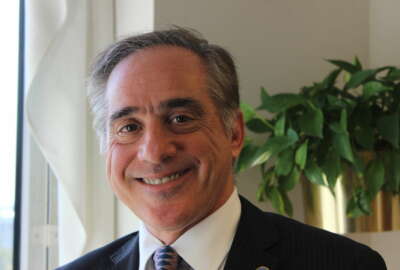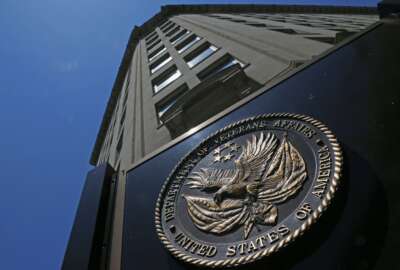
VA pilots health care apps as new push for major reorg emerges
Roughly half of a congressionally appointed commission to reform the Veterans Affairs Department suggested an expansion of community care for veterans and a...
The Veterans Affairs Department is piloting new tools to give veterans more control over their own health care.
The tools are part of the myVA Access initiative, which VA Undersecretary for Health David Shulkin announced during the Association of Health Care Journalists conference in Cleveland, Ohio, April 8.
Shulkin introduced the Veteran Appointment Request App, which lets veterans view, schedule, cancel and keep track of primary and mental health care appointments, the department said in a press release. The app is available in 10 locations now, and VA expects all veterans will have access to it by early 2017.
VA also is piloting a feature on 10 sites that lets veterans check appointment wait times in real time as part of the department’s new scheduling software.
The new program comes on the heels of a new “strawman” proposal from roughly half of the congressionally-appointed Commission on Care, which suggested VA cut and close many of its care providers and medical centers over the next 20 years.
The strawman document, which Federal News Radio obtained, pitches an expansion of community care providers and a reorganization of the Veterans Health Administration. VHA would have two offices: one to manage administrative and payer services, and another to focus on the aspects of clinical care that VA would still provide.
“Day-to-day management of the transformation will require significant reorganization within VHA,” the document said. “The VHA organizational structure should staff to the skills and expertise needed for the transformation, as well as managing the current clinical program. As the balance of VA and community care changes, and the resources should be reallocated accordingly.”
The Veterans Access, Choice and Accountability Act of 2014 mandated Congress appoint a 15-member commission to study veterans’ access to care and the Veterans Health Administration’s structure. The commission’s final report is due to President Barack Obama, Congress and VA Secretary Bob McDonald by June 30.
The document does not explicitly use the word “privatization” to describe the commissioners’ push to expand community care, but that’s the fear of the American Federation of Government Employees (AFGE) and some veterans service organizations.
“They’re trying to privatize it [VA],” said Marilyn Park, legislative representative for AFGE. “It would basically diminish the executive branch authority, because the authority would lie with the board instead of the cabinet-level secretary.”
The proposal emerged as VA and Congress continue to debate the role of the department — and how the agency can improve its customer service, better provide comprehensive care and let veterans have some control over their appointments at the same time.
More community care, fewer VA facilities
The VA acknowledged: it cannot meet all of veterans’ health care demands alone. The department created 3 million authorizations for veterans to receive private care between February 2015 and January 2016 — a 12 percent increase in authorizations over the previous year.
But a complete shift to private sector care isn’t the solution either, Garry Augustine, executive director of Disabled American Veterans (DAV) service and legislative headquarters, said.
“If I were just to have been given a card and [told] ‘OK, here you go, good luck; go find your doctors and your physical therapists and your orthotists and prosthetists,’ at 21-years-old, I would have been lost,” said Augustine, who returned from the Vietnam War with several injuries and health issues. “Instead, I had the VA to go to where they took care of me from A to Z. I didn’t have to go around and see where I needed to be seen for different conditions or find a physical therapist. It was all there. I walked in the door of the VA hospital [and] it was all there.”
Augustine said DAV is encouraged by VA’s proposals to develop a coordinated, integrated system of care for veterans.
The strawman document also proposed a systematic closure of some VA facilities, modeled after the Defense Department’s Base Realignment and Closure (BRAC).
Transitioning facilities should impact VHA employees as a little as possible, the document said. Community providers will take on more of the demand from veterans and should consider hiring displaced VHA employees, the document said.
“It would be devastating to the VHA workforce, which is one-third veterans, as we know,” Park said. “That’s a lot of people who chose to work at the VA because of dedication to veterans … people who are service-connected disabled veterans who work in the boiler room, and the housekeepers, the police and the food service. That’s a lot of people losing their federal jobs.”
It’s unclear just how many federal employees could stand to lose their jobs if VHA were to close some of its medical centers. The commissioners did not specify how many facilities should close, but the strawman document suggested closing five medical centers within the first three years.
“Then, in every two-year cycle, transition an additional 10 to 15 medical centers and additional out-patient facilities,” the document said. “The entire transition process will take several years for each facility. The long-term objective is the overall transition to community care.”
Governance board
The strawman document suggested creating a governance board, modeled after a private company’s fiduciary board, with 11 voting members. The President, Speaker of the House, House Minority Leader, Senate majority and minority leaders would each appoint two members. The VA Secretary also would sit on the board for the duration of his tenure at the department. Other members would serve for staggered, seven-year terms, the document said.
This board would “decide and direct” the commission’s proposed transformation process, which would include reviewing and approving the VA budget request, some acquisitions, major VHA operational plans, financial audits and other departmental business and strategic plans, the document said.
“You would wonder then what would be the role of the VA secretary and Congress, who are the ones that are supposed to oversee what’s happening in the VA,” Augustine said. “You’re putting another layer of bureaucracy in, taking the power away from the people that are supposed to be overseeing any government agency.”
Commission Chairwoman Nancy Schlichting said the proposal described in the strawman document is one of several the group is considering.
“The document was created by a subset of commissioners to describe their personal ideas, which ultimately facilitated and focused public discussion and prompted new proposals,” she said in a statement. “It was not presented as a final report. It represents options on a range of possibilities the commissioners are evaluating as they work toward a consensus decision on their recommendations.”
Park said she doesn’t believe Congress and the current administration would push these proposals through if they made it into the commission’s final June report. But AFGE is concerned how the commission is proposing these changes.
“Sometimes bad things happen, death by a thousand cuts,” she said. “We can’t let the sixth cut go forward. It’s a big one. It’s not all in one fell-swoop, but it’s a very dangerous direction to go. It’s not just shrinking the VA, it’s changing the entire way veterans get care.”
Copyright © 2024 Federal News Network. All rights reserved. This website is not intended for users located within the European Economic Area.
Nicole Ogrysko is a reporter for Federal News Network focusing on the federal workforce and federal pay and benefits.
Follow @nogryskoWFED
Related Stories






